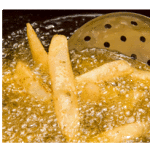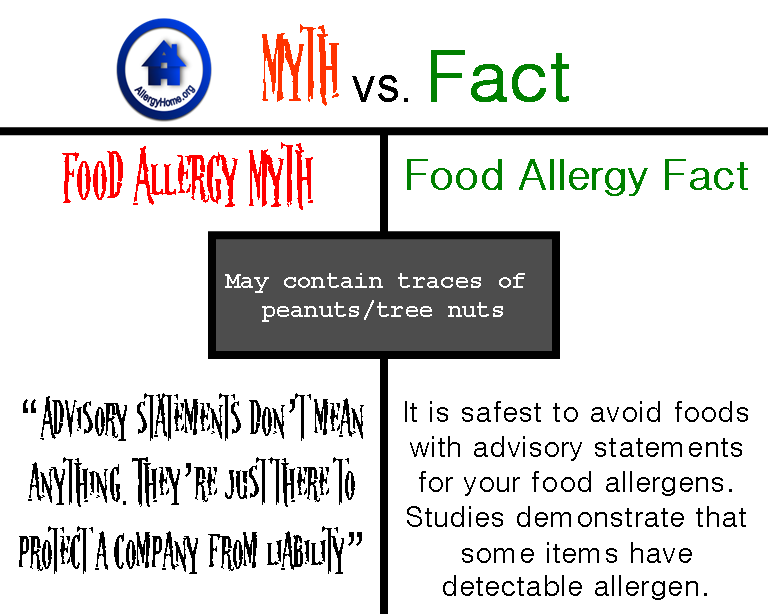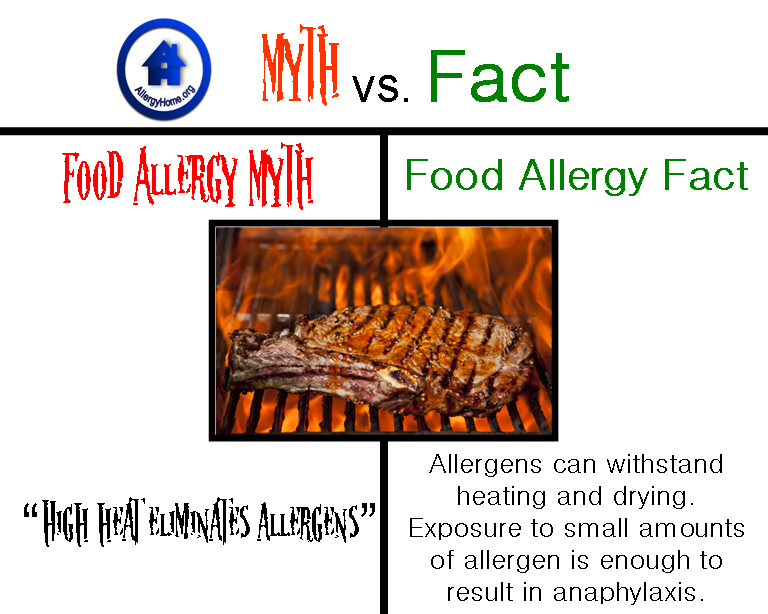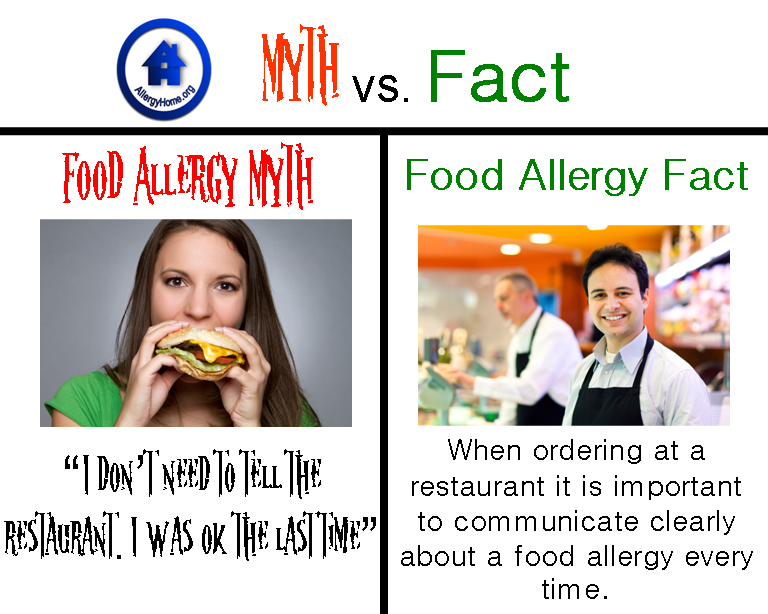Written by Michael Pistiner MD, MMSc
Avoiding allergen is necessary to prevent allergic reactions. Label reading, avoiding hidden ingredients and preventing cross-contact are key to avoiding allergens. Food allergy myth can be the cause of accidental exposures that can result in allergic reactions and anaphylaxis. We will now debunk, bust, and expose three food allergy myths.
Food Allergy Myth: “Advisory statements don’t mean anything. They’re only there to protect a company from liability.”
Food Allergy Fact: It is safest to avoid foods with advisory statements like “produced in a facility that…” or “may contain…”. Studies have found that some products with advisory statements contain enough allergen to cause reactions. For more information and a link to one of the studies see Living Confidently With Food Allergy Handbook; Understanding Labels Chapter. Consider this food allergy myth debunked!
Commentary: Some families note that their child has been OK with a product in the past and assume that future products will also be safe. We all need to keep in mind that in the case of cross-contact with a manufacturer, levels of allergen may not always be the same for all items in question . For example, bags of the candy produced at the beginning of a production run may have a high level of whatever was produced on the equipment just prior to switching runs. Some recommendations regarding cautionary statements vary depending on the allergen in question and the individual child. As with any food allergy management strategy, discuss this with your healthcare provider.
Food Allergy Myth: High heat eliminates allergens.
Food Allergy Fact: Remember that high heat and drying do not eliminate allergen. Clean cooking surfaces, pots, pans, plates and utensils with soap and water; and surfaces with soap and water, commercial cleaners or commercial wipes. Make sure no chunks are left (even if dried out). For more on preventing cross-contact see Living Confidently With Food Allergy; Cross-contact chapter. Food allergy myth, busted! Some recommendations vary depending on the allergen in question and the individual child. As with any food allergy management strategy, discuss this with your healthcare provider.
 Commentary: This food allergy myth is particularly important to know when eating an item that is potentially cooked on a common grill or cooked in a common vat of oil or frialator. For example, you may not be getting only french-fries, but everything else that was cooked before, in the same frialator like shrimp (shrimp poppers), chicken(chicken fingers), cod (fish sticks), clams (fired clams), etc.
Commentary: This food allergy myth is particularly important to know when eating an item that is potentially cooked on a common grill or cooked in a common vat of oil or frialator. For example, you may not be getting only french-fries, but everything else that was cooked before, in the same frialator like shrimp (shrimp poppers), chicken(chicken fingers), cod (fish sticks), clams (fired clams), etc.
Food Allergy Myth: “I don’t need to tell the restaurant. I was OK the last time.”
Food Allergy Fact: Always let the people who are preparing your meal know that you have a food allergy. It will help them guide you with your choice and help them know that they need to read all labels, be cautious about potential hidden ingredients, and prevent cross contact with the food that you are allergic to. Remember to always communicate. For more restaurant tips see Living Confidently With Food Allergy; Restaurant chapter. Food allergy myth, exposed!
Commentary: Keep in mind that great communication is always needed, even in restaurants that list ingredients for menu items, claim to be food allergy aware, etc. Very different strategies and care can be given if an allergen is known. Always communicate clearly!
From AllergyHome’s Food Allergy Myth vs. Fact Facebook Awareness Campaign Feb. 2013
For more on food allergen avoidance see:
1) Living Confidently With Food Allergy Handbook: A free, easy to use, handbook designed to give parents the tools to keep their children with food allergies safe and happy while addressing their emotional needs. This fact based guide was reviewed by internationally recognized food allergy experts. This American and Canadian collaboration was lead by Anaphylaxis Canada and is available online and in PDF.
2) How to Prevent Food Allergy Reactions: This 8 minute slideshow with audio outlines strategies to avoid exposure to food allergens in and out of the school setting. The presentation discusses the importance of label reading and avoiding hidden allergens and cross-contact.
(Please note that this is for educational purposes only. The information provided is not intended to be a replacement or substitute for professional medical advice. Any information that you have received from AllergyHome.org should be verified with your licensed health care provider).



I have heard that some kids with milk allergy can eat food cooked with milk because some how this denatures the protein. From the Myth busters posted I see this is not correct. Would one then assume the allergy is not anaphylactic in nature or is this always an individual thing and the child has been lucky…perhaps because the amount was less?
Thanks for this Ronda. True, some kids with milk allergy can tolerate some baked milk products. This is similarly seen with kids with egg allergy that can tolerate some baked egg products. As with any information from internet sites, prior to any changes in management families must discuss with their healthcare providers. In the case of children tolerating milk baked into muffins or bread, the milk protein does change in shape during the heating process that occurs in the oven, making it less recognizable. Still caution though on common grills and cooking surfaces as butter and cheese can come in contact with a food and not necessarily be heated thoroughly enough to make them safe.
To determine my son’s ability to consume dairy baked into muffins, we did a food challenge with a board certified allergist–after the allergist determined this was a possibility.
We then stair stepped him up to baked cheese on pizza and in a several months will visit unbaked dairy. All under an allergist’s care in a medical setting.
Excellent Myths busted! Especially the myth about heating. I was at restaurant the other day who sworn up and down that they are allergen safe and will clean their grill to cook my son’s food. I was not comfortable since it was an Asian style large 5 foot grill that has nut products on it’s surface all day long.
Thank you for the good data.
Thanks for the kind words Caroline!
Mike–excellent work, as always. But you and I should do a pro-con about allergen thresholds and the tremendous untapped potential that exists in defining theses els so we can get better information about the true risk of cross-contamination. Or what “may” or “might” contain really means in terms of risk of that level could be quantified.
Thanks Matt,
You are totally correct. Working towards figuring out an approach toward allergen thresholds and the definition of levels is so important. For now though we got to work with what we got. And as usual, families should work with their allergists to determine what their approach will be taking the current literature and the specific child into account.